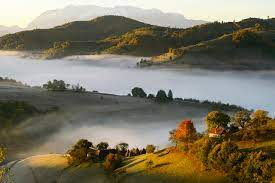ROMANIA ~ LAND OF SURPRISES
Romanis is a country at the crossroads southeastern Europe. The country is brimming with natural, architectural and artistic treasures. This lesser known country is the largest of the Balkan countries. Ukraine, Hungary, Serbia, Bulgaria, Moldova are its neighbours and the Black Sea is on its coastline. Its capital and largest city is Bucharest.
Brief history
The name “Romania” comes from the Latin word “Romanus” which means “citizen of the Roman Empire.” Numerous empires ruled the land, from the Romans and Ottomans to the Austro-Hungarians. Romania was part of both the world wars and got bombed severely in World War II. After the war, the country fell into communist rule for four decades, which ended in 1989 with the execution of the ruler Nicolae Ceauescu. The country went through a difficult phase during this time, transiting from communism to democracy. It signed the NATO treaty along with seven other countries in 2005. Eventually, it became part of the European Union in 2007. Today, Klaus Iohannis is the democratically elected President of Romania.
Geography
Mountains make up around a third of the country. The Carpathian Mountains are divided into three different major ranges – the Eastern, Western and Southern Carpathians (also called the Transylvanian Alps). Forests surround these Alps and the Caras-Severin county is a region full of unique landscapes. It has three national parks to its credit. The Cheile Nerei-Beusnita National Park is the most noted and the Bigar Cascade waterfalls here is a sight to behold. It is listed as the most beautiful waterfalls in the world. These forest regions are protected areas that are home to a variety of biodiversity, including many amphibians, birds, bats, and snakes. More than half of all brown bears in Europe can be found in these forests, accounting for almost 6000 in number.
There are over 3,000 lakes and many rivers. A few of them are glacial. The Scarisoara glacier underneath the Bihor mountains is more than 3,500 years old and is Europe’s second-largest underground glacier. The Danbe River, which starts in Germany, travels through seven countries and flows into the Black Sea in Romania. Before flowing into the sea, it creates a delta, which is the second largest and best-preserved in Europe. The Delta is a UNESCO Biosphere Reservation and a protected natural habitat and wetland for rare species of animals and plants. The Danube to the Black Sea canal is the world’s third-longest navigation route, after the Suez and the Panama canals. The statue of Dacian king Decebal, carved in the rocky bank of the river, is the tallest rock sculpture in Europe (135 feet tall).
Heritage
In total, Romania has to its credit around 8 UNESCO World Heritage sites.
The most iconic landmarks are the churches. Sapanta Peri monastery, carved in wood by the people from Maramure, is the tallest church in the world. The Merry Cemetery is situated in the village of Sapana and is certainly unique. It features painted crosses with satirical epitaphs that reveal the message of the deceased to the living. The Black Church of Braov is another church that got its name after it got destroyed by fire. It has a magnificent Bucholz organ and the biggest collection of oriental carpets in Europe.
Other fascinating sites are the Transfagarasan Highway, Pele’s castle, the Palace of Parliament, Astra Museum of Folk Civilization, Crtureti Carusel bookstore and many more…
Picture Credit: Google

Leave a Reply